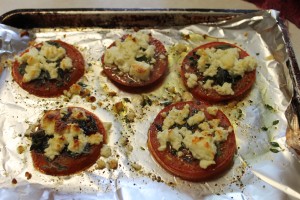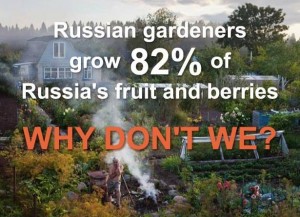Summer Bounty…Fresh Tomatoes !
Stephanie Kelley
Sweet, fresh and juicy home grown tomatoes are among my very most favourite food. Our growing season is so brief, we only get to enjoy them for a short time each summer, and that time is now!

browned and the tomatoes & fresh herbs are cooked through
Garden tomatoes are delicious just as they are, but last week I came across a simple recipe that turns sliced tomatoes into a sublime side dish.
Broiled Tomatoes with Feta Cheese & Fresh Herbs
- Sliced fresh tomatoes
- Feta Cheese
- Sea Salt & Fresh Ground Black Pepper
- Fresh Oregano or other herbs
- A broiler or toaster oven
Slice your fresh tomatoes and lay them on a broiler sheet. I use my little toaster oven.
Drizzle the slices with extra virgin olive oil and flop them over so they have a bit of oil on both sides.
Season with salt and pepper, and then cover the slices with the fresh herbs.
Then sprinkle the tops with crumbled feta and pop the tomatoes into your broiler. Since I’m using a toaster oven, it takes them awhile to broil through and for the cheese to toast, about 15 minutes.
You want the feta to get a little bit brown on top, and for the tomatoes and herbs to cook through.
Remove from oven and enjoy! I’ve enjoyed this dish as a light luncheon just by itself, and as a side dish for every meal.
The tomatoes make a nice flavourful and brothy juice that was great with some smashed new potatoes, and today I had this dish for breakfast along with some scrambled eggs.
I have several kinds of herbs growing on my windowsill, and I originally made these with oregano. Use lots of it, too! The oregano gets a little toasty where it’s exposed to the broiler elements which makes it quite tasty.
I decided to give my oregano plant a break from duty today, and so made the dish with both regular and lemon thyme. Tasted great, and I’m sure fresh basil would be yummy in this dish too…I just don’t have any right now.
I’ve been laying into the fresh tomatoes because this is the only time of year I eat them. Store bought tomatoes make look red and ripe, but you know they don’t taste anything like real tomatoes!
For an eye-opening expose of the commercial tomato industry, check out the book “Tomatoland: How Modern Industrial Agriculture Destroyed Our Most Alluring Fruit” by investigative food journalist Barry Estabrook.
The book grew out of an award winning essay Estabrook wrote for Gourmet Magazine titled “Politics of the Plate: The Price of Tomatoes” which you may read here, and the NB Public Library has the book in their system.
We’ve become accustomed to seeing tomatoes all year round at our supermarkets, but these commercial tomatoes are produced at an appalling cost in human misery and to our environment.
Florida is the tomato capital of America. Thousands of Latino and Indio migrant workers come to Florida to work in the fields, where they are treated as slaves without rights.
Almost everything a tomato farmer buys to raise a crop is petroleum based: the chemical fertilizers, pesticides, plastic row covers, plastic bins, and the fuel for the tractors and trucks.
To grow a crop of these tomato-like fruits, field workers prepare the soil by drenching it with a chemical bath of pesticides and herbicides to kill every living thing in the soil.
There are no actual natural nutrients left in this soil, so the tomato plants will be fed more petroleum based chemicals to grow.
The soil is then covered with plastic row covers, and the tomato seedlings are planted in holes punched through the covers.
Throughout the growth cycle, the fields are sprayed with more than 100 different herbicides and pesticides. The migrant field workers handle the chemicals without any protective gear whatsoever.
The workers become sick with cancer, lung diseases and organ damage, and mothers give birth to babies with terrible birth defects.
These commercial tomatoes cannot be picked by machines, everything to do with growing them must be done by human hands except for transporting them.
The tomatoes are picked hard and green and then artificially gassed until they are red enough to entice the unwary into buying them.
Have you ever been suckered into buying those so-called vine-ripened tomatoes? They are usually sold still on the stem to convince you of their authenticity, and they even have a real tomato aroma.
But, all they are is premium priced water, as they are grown hydroponically. As they are grown in water, and fed chemical nutrients to grow, they have no flavour.
Growing vegetables hydroponically is like a human being trying to live on supplements alone… it’s not healthy!
Incidentally, canned tomatoes are grown in California, where they are picked when they are actually ripe and then immediately taken to the processing plants, which is why canned tomatoes actually have some flavour.
While I’m on this little tomato kick here, the most popular tomato product in North America is, of course, ketchup.
The first ketchup recipe was printed in 1758 in Eliza Smith’s cookbook “The Compleat Housewife”. Her “English Catchup” was a savoury chutney containing anchovies and sweet spices, but no tomatoes.
The first ketchup recipe actually containing tomatoes wasn’t published until 1812, and the recipe still called for anchovies.
More recipes were developed, and after the Civil War, its popularity really took off, as it was called the “sauce of sauces” and the New York Tribune wrote that ketchup was America’s national condiment “that was on every table in the land”.
In 1882, company founder Henry Heinz began patenting what would become the company’s famous ketchup bottles.
Today, statistics say ketchup is found in 97 percent of North American households.
In 1981 the USDA chairman declared ketchup to be a vegetable in order to justify the Reagan administration budget cuts in the school lunch program.
These days, however, commercial ketchup has come a long and sorry way from its roots as a savoury condiment.
A bottle of Heinz Ketchup now contains: Tomato concentrate, distilled vinegar, high fructose corn syrup, corn syrup, salt, spice, onion powder and natural flavouring.
Both high fructose corn syrup and the regular corn syrup are made from genetically modified corn, the stuff that either contains insecticide right inside the cells of the plant or has been modified to withstand massive doses of the deadly herbicide glyphosate. Not to mention that HFCS is very unhealthy for human bodies.
And what about that “natural flavouring” at the end of the list? It’s monosodium glutamate, of course, our old buddy MSG!
